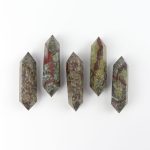Unveiling the Enigmatic World of Quartz
Quartz, the second most abundant mineral on Earth, captivates scientists and enthusiasts alike with its extraordinary properties and diverse applications. Its versatile nature extends from jewelry to electronics, construction to medicine, making it an indispensable material in modern society. Embark on a journey to unravel the fascinating facts and innovative uses of quartz.

Physical Characteristics of Quartz
- Quartz is composed of silicon and oxygen, forming a tetrahedral structure.
- It exhibits variable transparency, ranging from vitreous to translucent.
- Its hardness on the Mohs scale is 7, indicating its resistance to scratching.
- With a density of approximately 2.65 g/cm³, quartz is lighter than most gemstones.
Crystal Properties of Quartz
- Quartz crystals occur in various forms, including hexagonal prisms, rhombohedra, and pyramids.
- Its piezoelectric property enables the conversion of mechanical energy into electrical energy.
- Quartz is optically active, polarizing and rotating light passing through it.
- Due to its high melting point, quartz remains stable even at extreme temperatures.
Applications of Quartz

Image Credit: Quartzpage.com
Jewelry and Gemstones
* Amethyst, citrine, and rose quartz are popular gemstones due to their vibrant colors and clarity. * Quartz crystals are often used in healing bracelets and necklaces.
Electronics
* Quartz crystals serve as the core component of oscillators in clocks, watches, and smartphones. * They stabilize frequency in electronic circuits. * The tunable frequency of quartz resonators enables precise timekeeping.
Construction
* Quartz sand is an essential ingredient in concrete, glass, and ceramics. * Its strength and durability enhance the longevity of structures.
Medicine
* Quartz fibers are utilized in laser surgery to remove tumors and tissues with minimal damage. * Its antimicrobial properties contribute to its use in wound dressings and medical devices.
Other Creative Applications
* Vibrating quartz plates power ultrasonic cleaners and fog machines. * Quartz can be sculpted into intricate art objects and decorative pieces. * Its optical clarity makes it ideal for prisms and lenses.
Quartz Statistics and Data
* The global silicon market, where quartz is the primary raw material, is projected to reach $120 billion by 2028. * The United States Geological Survey estimates that over 280 million tonnes of quartz are produced annually. * Quartz components account for up to 90% of the global watch market. * In the medical field, quartz fibers are used in approximately 50% of laser surgeries.
Innovative Applications of Quartz
Ongoing research and technological advancements are broadening the horizons of quartz applications. Here are a few innovative concepts being explored: * **Self-healing materials:** Quartz nanoparticles can be embedded into materials to facilitate self-healing properties, enhancing durability. * **Quantum computing:** Quartz crystals may be suitable for building quantum computers, offering unprecedented computational power. * **Energy harvesting:** Quartz’s piezoelectric properties can be harnessed to generate power from vibrations and motion. * **Biomedical sensors:** Quartz-based sensors are being developed to detect biomarkers in real time for early disease diagnosis. * **Security and anti-counterfeiting:** Quartz crystals can be used to create unique identification codes for products and documents, preventing counterfeiting.
Useful Tables on Quartz

Image Credit: Quartzpage.com
Table 1: Quartz Varieties and Colors
| Variety | Color | |—|—| | Amethyst | Purple | | Citrine | Yellow | | Rose Quartz | Pink | | Rock Crystal | Clear | | Smoky Quartz | Brown | | Milky Quartz | White |
Table 2: Physical Properties of Quartz
| Property | Value | |—|—| | Hardness (Mohs) | 7 | | Density | 2.65 g/cm³ | | Cleavage | Indistinct | | Luster | Vitreous to greasy | | Transparency | Translucent to opaque |
Table 3: Applications of Quartz
| Industry | Application | |—|—| | Jewelry | Gemstones, healing bracelets | | Electronics | Clock oscillators, frequency stabilizers | | Construction | Concrete, glass, ceramics | | Medicine | Laser surgery, wound dressings | | Other | Ultrasonic cleaners, decorative art |
Table 4: Historical and Cultural Significance of Quartz
| Period | Significance | |—|—| | Ancient Egypt | Used in jewelry and religious artifacts | | Middle Ages | Believed to have healing properties | | Renaissance | Popular in decorative art and carvings | | 19th Century | Used in clocks and optical instruments | | Modern Era | Indispensable in electronics and technology |
Frequently Asked Questions (FAQs) about Quartz
1. **What is the difference between quartz and glass?** Quartz is a naturally occurring mineral, while glass is a man-made material produced by melting and cooling molten silicon. 2. **Why is quartz so durable?** Quartz’s hardness makes it resistant to scratching and wear. Its crystalline structure provides exceptional strength and longevity. 3. **Can quartz be found in different colors?** Yes, quartz exhibits a wide range of colors, including purple (amethyst), yellow (citrine), pink (rose quartz), and brown (smoky quartz). 4. **What are some uncommon applications of quartz?** Quartz can be used in self-healing materials, quantum computing, energy harvesting, and biomedical sensors. 5. **Is quartz safe for use in jewelry and clothing?** Yes, quartz is generally safe for use in jewelry and clothing due to its non-toxic nature and lack of radioactivity. 6. **Can quartz increase spiritual energy?** There is no scientific evidence to support the claim that quartz has spiritual or healing properties. However, it may provide a sense of comfort and aesthetic enjoyment.
Conclusion
Quartz, with its captivating beauty and practical versatility, holds a prominent place in the tapestry of human civilization. As scientific research and technological advancements continue, new applications and innovations emerge, promising to further enhance our understanding and utilization of this remarkable mineral.




























